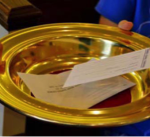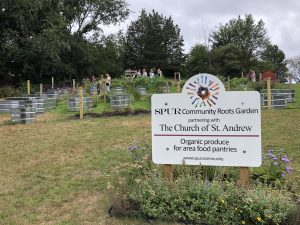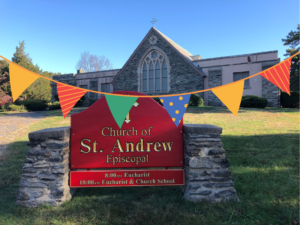The Wyman Memorial Church of St. Andrew
The Marblehead Church familiarly known as “St Andrew’s” began in the nineteenth century, as a dream in the heart of Isaac Chauncy Wyman, a life-long resident of nearby Salem, who was a communicant of St. Michael’s Church in Marblehead. Among Wyman’s extensive real estate holdings was a large tract of land in Marblehead, bordering the Forest River and containing the Wyman family burial plot. In contrast to the pastures surrounding it, this land was densely covered with trees; hence, it was known as Wyman’s Woods. Few people lived in the area, which was considered at the turn of the century to be out in the country, but as the area began to build up, Mr. Wyman became concerned about the absence of Sunday school opportunities for the children.
When he died in 1910, Isaac Wyman bequeathed part of this land and a sum of money for the building of a memorial chapel near the burial plot. The chapel was to be used for religious services, for the spiritual education of children of all denominations, and for social activities of neighborhood groups. Mr. Wyman seems to have been an early advocate of ecumenism, for he stipulated that the bequest first be offered to St Michael’s, but, if his own parish did not act within a certain number of years, the opportunity was to be opened to any Marblehead church.
In 1922, Lyman Rollins, then rector of St. Michael’s Church, petitioned and received permission to undertake the construction and maintenance of the chapel. The original building was completed in the fall of 1924.
In 1924, the congregation was organized as a mission served by the Reverend David R. Haupt, a senior at the Episcopal Theological School, Cambridge, as Curate-in-Charge. At the time, Mr. Haupt was serving as curate to the Reverend Robert B. Parker, Rector of St. Michael’s Church in Marblehead. Several lay members of the new church canvassed the neighborhood, encouraging parents to send their children to St. Andrew’s for Bible study and recruiting adults for the choir.
By 1929, the dedicated involvement of early lay leaders led to school enrollment of 109 children. A parish hall was constructed even before the church itself was consecrated in 1930.
Over the years, the building was expanded. The bell tower was erected in 1964, through a bequest from the estate of Martha Higginson Hills (1868-1945). Built in the style of the traditional free standing bell towers of the early middle ages in England, it houses a historic Marblehead bell. The bell was made in Sheffield, England in 1861 and brought to Marblehead, where it hung in the old South Church until the first great Marblehead fire destroyed the church. It is the same bell which called the men of Marblehead to fight in the Civil War; subsequently it was hung in the first School Street fire Station and was there until Marblehead’s second great fire destroyed the station. Known as “Old Calamity”, it was rung for fires and other calamities. It was then hung in the belfry tower of the Methodist Church on Summer Street and remained there until St. Stephen’s was moved to its new church and present location. The bell was then turned back to the town and was given a place of honor at St. Andrew’s Church.
Clergy of St. Andrew’s
Rev. Roy M. Grindy, 1927-1965
Rev. Howard “Ward” Gamble, Jr., 1966-1995
Rev. Paul Garrett (interim), 1995-1997
Rev. Kevin D. Bean, 1997-2005
Rev. Marya De Carlen (associate rector), 1999–2003
Rev. R. Arrington Chambliss (associate rector), 2004-2008
Rev. Beulah Kouloris (interim), 2005-2006
Rev. Mary Scott Wagner, 2006-2008
Rev. Jennie Anderson (temporary)
Rev. Susan Russell (priest-in-charge), 2008-2011
Rev. C. Clyde Elledge II, 2011-
Rev. Cara Rockhill (assistant rector), 2019-2020
Adapted from parish history written in 1996 and updated later by Alan Daley and Janet and Tim Parker



 Century Celebration, 2023–24! In preparation for our centennial, we are making plans for a year's worth of celebrations. We will be asking all of you for ideas and assistance.
Century Celebration, 2023–24! In preparation for our centennial, we are making plans for a year's worth of celebrations. We will be asking all of you for ideas and assistance. 